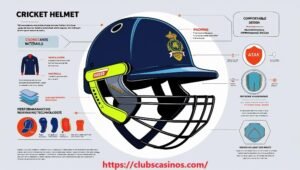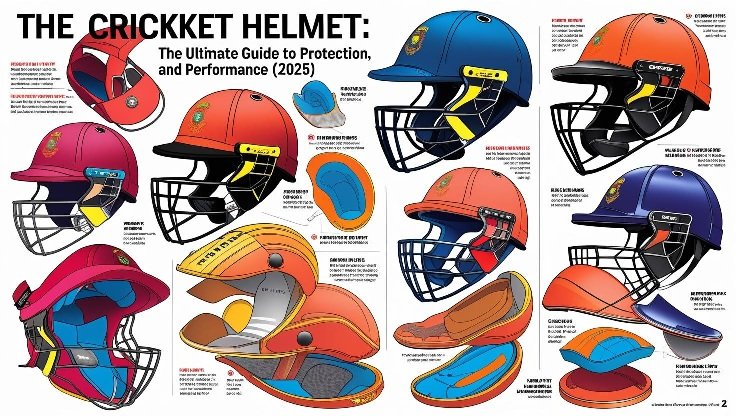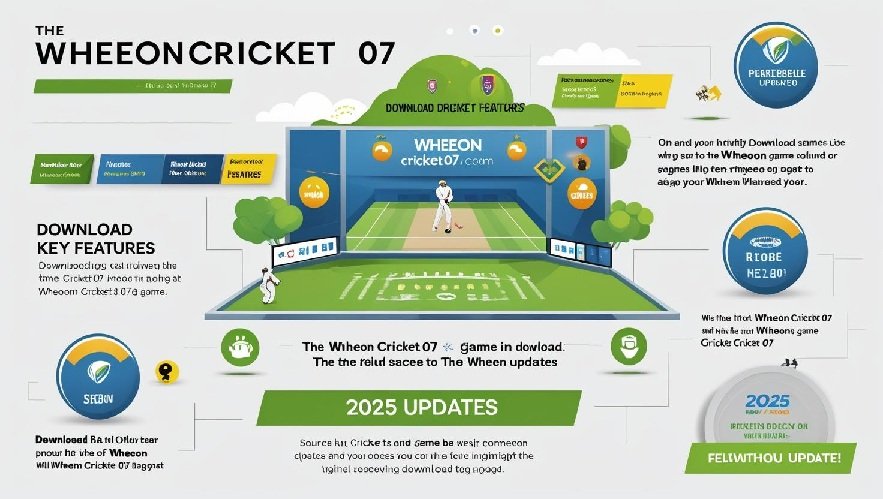Cricket is a game of passion, skill, and strategy, but it is also a sport where safety plays a crucial role—especially when facing fast bowlers. The cricket helmet has evolved over the decades, becoming a vital piece of equipment for batsmen, wicketkeepers, and close-in fielders. This comprehensive guide dives deep into everything you need to know about cricket helmets—why you need one, how to choose the best helmet, safety standards, top brands, maintenance tips, and much more.
Table of Contents
-
Introduction to Cricket Helmets
-
Importance of Wearing a Cricket Helmet
-
Evolution of Cricket Helmets
-
Key Components of a Modern Cricket Helmet
-
Types of Cricket Helmets
-
How to Choose the Right Cricket Helmet
-
Cricket Helmet Size Guide
-
Top Cricket Helmet Brands in 2025
-
Best Cricket Helmets to Buy in 2025
-
Maintenance Tips for Cricket Helmets
-
Common Myths About Cricket Helmets
-
Frequently Asked Questions
-
Conclusion
Introduction to Cricket Helmets
A cricket helmet is designed to protect players from head injuries caused by cricket balls traveling at high speeds. Modern cricket helmets feature advanced safety materials, adjustable fittings, and improved comfort, making them indispensable in today’s competitive cricket scene.
From young aspiring cricketers to professional athletes, a high-quality cricket helmet ensures not only protection but also confidence while playing.
Importance of Wearing a Cricket Helmet
Helmets have become mandatory in most professional formats due to several high-profile incidents and growing awareness of sports safety. Here are some reasons why wearing a cricket helmet is non-negotiable:
-
Protection Against Impact: Cricket balls can exceed speeds of 90 mph, capable of causing serious injuries. Helmets absorb and deflect these impacts.
-
Compliance with Rules: Most leagues and cricket boards require players to wear helmets while batting and fielding close to the wicket.
-
Confidence Booster: A well-fitted helmet allows players to focus on their performance without worrying about injury.
-
Prevention of Concussions: Helmets reduce the risk of concussions, which can have long-term effects on health.
Evolution of Cricket Helmets
Early Days:
-
Before the 1970s, players like Sunil Gavaskar and Viv Richards faced fast bowlers without any headgear.
1970s to 1990s:
-
Dennis Amiss of England was the first to wear a helmet in 1978.
-
Early designs were bulky, heavy, and had limited visibility.
2000s:
-
Manufacturers have introduced lighter materials like polycarbonate shells and improved ventilation systems.
2020s and Beyond:
-
Helmets now feature advanced impact-resistant materials, adjustable grilles, stem guards, and compliance with ICC safety standards.
-
Modern helmets are lighter, safer, and more comfortable than ever.
Key Components of a Modern Cricket Helmet
Understanding the anatomy of a cricket helmet helps you make informed decisions. Here are the essential parts:
-
Outer Shell: Made from polycarbonate or composite materials to resist impact.
-
Inner Padding: High-density foam or EPS lining for shock absorption.
-
Grill/Face Guard: Usually made of stainless steel or titanium to protect the face while ensuring visibility.
-
Chin Strap: Keeps the helmet securely in place.
-
Stem Guard: An attachment at the back to protect the vulnerable neck area.
-
Ventilation System: Allows airflow to keep the player cool during long innings.
Types of Cricket Helmets
1. Batting Helmets:
-
Designed for batsmen to withstand fast deliveries.
-
Often includes stem guards for neck protection.
2. Wicketkeeping Helmets:
-
Lightweight, with open grills and adjustable visors, designed for wicketkeepers standing up to the stumps.
3. Fielding Helmets:
-
Used by close-in fielders (short-leg, silly point) to protect against deflections and close-range shots.
4. Junior Cricket Helmets:
-
Specially designed for younger players with smaller head sizes and extra padding.
How to Choose the Right Cricket Helmet
Choosing the right helmet involves several key considerations:
✅ 1. Safety Standards:
Look for helmets certified by the British Standard BS7928:2013 or the latest ICC regulations.
✅ 2. Fit and Comfort:
A snug fit without being too tight ensures maximum protection. Adjustable inner padding and straps help achieve the right fit.
✅ 3. Weight:
Lighter helmets reduce neck strain during long innings. Titanium grills are lighter than steel.
✅ 4. Visibility:
The grill should offer clear vision without compromising safety.
✅ 5. Ventilation:
Good airflow is essential, especially in hot climates.
✅ 6. Additional Features:
Removable stem guards, sweatbands, and anti-bacterial linings are great additions.
Cricket Helmet Size Guide
| Head Circumference (cm) | Helmet Size |
|---|---|
| 51 – 53 cm | Small Junior (SJ) |
| 53 – 55 cm | Junior (J) |
| 55 – 58 cm | Small (S) |
| 58 – 61 cm | Medium (M) |
| 61 – 64 cm | Large (L) |
| 64+ cm | Extra Large (XL) |
Tip: Always measure your head circumference using a flexible tape measure around your forehead, just above your eyebrows.

Top Cricket Helmet Brands in 2025
🏏 1. Masuri
-
Pioneers in cricket helmet safety.
-
Known for their advanced designs and quality stem guards.
🏏 2. Shrey
-
Lightweight helmets with stylish looks.
-
Popular among international cricketers.
🏏 3. SG (Sanspareils Greenlands)
-
Affordable, reliable, and widely used in domestic circuits.
🏏 4. Gray-Nicolls
-
Balanced design with comfort and performance.
🏏 5. Kookaburra
-
Excellent for junior cricketers and entry-level players.
Best Cricket Helmets to Buy in 2025
⭐ Masuri E-Line Titanium Helmet
-
Highest level of protection with lightweight titanium grill.
-
Used by professionals like Jos Buttler and Marnus Labuschagne.
⭐ Shrey Masterclass Air 2.0
-
Extremely light with superior ventilation.
-
Complies with BS7928:2013 standards.
⭐ SG Optipro Cricket Helmet
-
Budget-friendly option with solid safety features.
-
Popular among club players.
⭐ Gray-Nicolls Ultimate 360 Pro
-
Complete 360° protection with an optional neck guard.
-
Stylish and functional.
⭐ Kookaburra Pro 600
-
Great for beginners and junior players.
-
Adjustable design with cushioned inner lining.
Maintenance Tips for Cricket Helmets
To ensure your cricket helmet remains in top condition:
-
✅ Clean Regularly: Wipe the outer shell with a damp cloth and air dry.
-
✅ Check for Cracks: Regularly inspect for any signs of damage or loose grill fittings.
-
✅ Avoid Direct Sunlight: Prolonged exposure can weaken the helmet’s shell.
-
✅ Replace After Impact: After a significant impact or visible damage, replace the helmet immediately.
-
✅ Store Properly: Keep the helmet in a cool, dry place, preferably in a helmet bag.
Common Myths About Cricket Helmets
❌ Myth 1: Helmets Reduce Performance
Truth: Modern helmets are lightweight and designed for comfort, causing no impact on performance.
❌ Myth 2: Only Fast Bowlers Require Helmets
Truth: Even spinners can cause unexpected deflections; helmets are crucial in every format.
❌ Myth 3: Expensive Helmets Are Always Better
Truth: While premium helmets have advanced features, mid-range helmets can offer excellent protection too, as long as they meet safety standards.
❌ Myth 4: Helmets Last Forever
Truth: Helmets typically have a lifespan of 3-5 years, depending on use and maintenance.
Frequently Asked Questions (FAQs)
✅ Q1: Can I wear sunglasses under a cricket helmet?
Yes, many modern helmets are designed to accommodate sunglasses without affecting comfort or vision.
✅ Q2: Is a stem guard necessary?
A stem guard provides additional protection to the neck and is highly recommended, especially against fast bowlers.
✅ Q3: How often should I replace my cricket helmet?
It is advisable to replace your helmet every 3-5 years or after a significant impact, whichever comes first.
✅ Q4: Are customized helmets allowed in matches?
Yes, as long as the helmet complies with cricket board regulations and safety standards.
Conclusion
A cricket helmet is more than just a piece of gear—it is a life-saving investment that boosts your confidence and ensures your focus remains on the game. Whether you’re a budding cricketer or a seasoned pro, selecting the right cricket helmet with certified protection, a comfortable design, and the right fit is crucial.
In 2025, with advancements in safety technology, there’s no excuse to compromise on head protection. Equip yourself with the best, follow safety protocols, and enjoy your cricketing journey with peace of mind.
Read Also: Clubs Casinos




Leave a Reply